Control of Bacterial Canker in Stone Fruit Trees by Chemical and Biological Products
Abstract
:1. Introduction
2. Materials and Methods
3. Results
4. Discussion
5. Conclusions
Author Contributions
Funding
Data Availability Statement
Conflicts of Interest
References
- Husseini, A.; Akköprü, A. The possible mechanisms of copper resistance in the pathogen Pseudomonas syringae pathovars in stone fruit trees. Phytoparasitica 2020, 48, 705–718. [Google Scholar] [CrossRef]
- Sayler, R.J.; Kirkpatrick, B.C. The effect of copper sprays and fertilization on bacterial canker in French prune. Can. J. Plant Pathol. 2003, 25, 406–410. [Google Scholar] [CrossRef]
- Bultreys, A.; Kałuzna, M. Bacterial cankers caused by Pseudomonas syringae on stone fruit species with special emphasis on the pathovars syringae and mors prunorum race 1 and race 2. J. Plant Pathol. 2010, 92, 21–33. [Google Scholar]
- Børve, J.; Perminow, J.I.S.; Wenneker, M.; Brurberg, M.B.; Stensvand, A. Pseudomonas syringae on young sweet cherry trees in Norway. IOBC-WPRS Bull. 2019, 146, 135. [Google Scholar]
- Kałuzna, M.; Ferrante, P.; Sobiczewski, P.; Scortichini, M. Characterization and genetic diversity of Pseudomonas syringae from stone fruits and hazelnut using repetitive-PCR and MLST. J. Plant Pathol. 2010, 92, 781–787. [Google Scholar]
- Kałuzna, M.; Puławska, J.; Sobiczewski, P. Bioróżnorodność fitopatogenicznych bakterii z rodzaju Pseudomonas, odkrycie gatunku Pseudomonas cerasi sp. nov. (non Griffin, 1911). In Materiały z Sympozjum, Aktualne Kierunki Badań Nad Chorobami Bakteryjnymi Roślin w Polsce; PAN: Warsaw, Poland, 2018; pp. 43–48. Available online: http://www1.up.poznan.pl/ptfit/sites/default/files/Documents/Sympozjum_2_Internet_04.12.18.pdf (accessed on 17 April 2023).
- Young, J.M. Pathogenicity and identification of the lilac pathogen, Pseudomonas syringae pv. syringae van Hall 1902. Ann. Appl. Biol. 1991, 118, 283–298. [Google Scholar] [CrossRef]
- Gardan, L.; Shafik, H.; Belouin, S.; Broch, R.; Grimont, F.; Grimont, P.A.D. DNA relatedness among the pathovars of Pseudomonas syringae and description of Pseudomonas tremae sp. nov. and Pseudomonas cannabina sp. nov. (ex Sutic and Dowson 1959). Int. J. Syst. Bacteriol. 1999, 49, 469–478. [Google Scholar] [CrossRef]
- Sobiczewski, P.; Broniarek-Niemiec, A.; Bryk, H.; Cieślińska, M.; Meszka, B. Atlas Chorób Drzew Owocowych; Czarnocka, A., Ed.; Wyd. Hortpress Sp. z o.o.: Warszawa, Poland, 2016; p. 113. ISBN 978-83-944529-7-1. [Google Scholar]
- Cazorla, F.; Vicente, A.; Ramos, C.; Sundin, G.W. Pseudomonas syringae diseases of fruit trees, progress toward understanding and control. Plant Dis. 2007, 91, 4–17. [Google Scholar] [CrossRef]
- Broniarek-Niemiec, A. Jak chronić pestkowe przed chorobami? Mies. Prakt. Sadow. SAD 2022, 4, 50–57. [Google Scholar]
- Broniarek-Niemiec, A. Ochrona czereśni do zawiązania owoców. Czereśnia 2022, 1, 18–23. [Google Scholar]
- Scheck, H.J.; Pscheidt, J.W. Effect of copper bactericides on copper-resistant and -sensitive strains of Pseudomonas syringae pv. syringae. Plant Dis. 1998, 82, 397–406. [Google Scholar] [CrossRef]
- Mikiciński, A.; Sobiczewski, P.; Berczyński, S. Efficacy of fungicides and essential oils against bacterial diseases of fruit trees. J. Plant Prot. Res. 2012, 52, 467–471. [Google Scholar] [CrossRef]
- Kałużna, M.; Sobiczewski, P. Virulence of Pseudomonas syringae pathovars and races originating from stone fruit trees. Phytopathologia 2010, 54, 71–79. [Google Scholar]
- Klimat Polski. Available online: https://www.imgw.pl/sites/default/files/2021-04/imgw-pib-klimat-polski-2020-opracowanie-final-pojedyncze-min.pdf (accessed on 17 April 2023).
- Compendium of Growth Stage Identification Keys for Mono- and Dicotyledonous Plants. BBCH Monograph, Edited by Uwe Meier. 2018, p. 204. Available online: https://www.politicheagricole.it/flex/AppData/WebLive/Agrometeo/MIEPFY800/BBCHengl2001.pdf (accessed on 17 April 2023).
- Korbas, M.; Paradowski, A.; Węgorek PJajor, E.; Horoszkiewicz-Janka, J.; Zamojska, J.; Danielewicz, J.; Czyczewski, M.; Dworzańska, D. Vademecum Środków Ochrony Roślin; Wydanie, I., Ed.; Wydawnictwo Agronom: Poznań, Poland, 2017; p. 675. [Google Scholar]
- Eğerci, K. Studies on the Sensitivity Level of Some Plant Pathogenic and Saprophytic Bacteria against Copper-Based Compounds. Master’s Thesis, Ege University, Graduate School of Natural and Applied Science,, Izmir, Turkey, 2015. Available online: file:///C:/Users/Admin1/Downloads/387249.pdf (accessed on 17 April 2023).
- Martins, G.; Miot-Sertier, C.; Lonvaud-Funel, A.; Masneuf-Pomarède, I. Grape berry bacterial inhibition by different copper fungicides. In Proceedings of the 39th World Congress of Vine and Wine, Bento Goncalves, Brazil, 24–28 October 2016; BIO Web of Conferences 7. p. 01043. [Google Scholar] [CrossRef]
- McLaren, G.F.; Vannese, J.L.; Marshall, R.R. Sulphur as an alternative to copper for the control of bacterial blast on nectarine fruit. N. Z. Plant Prot. 2005, 58, 96–100. [Google Scholar] [CrossRef]
- Collina, M.; Donati, I.; Bertacchini, E.; Brunelli, A.; Spinelli, F. Greenhouse assays on the control of the bacterial canker of kiwifruit (Pseudomonas syringae pv. actinidiae. J. Berry Res. 2016, 6, 407–415. [Google Scholar] [CrossRef]
- Merry, R.; Tiller, K.G.; Alston, A.M. Accumulation of copper, lead and arsenic in some Australian orchard soils. Aust. J. Soil Res. 1983, 21, 549–561. [Google Scholar] [CrossRef]
- Sharafi, Y. Effects of copper and lead on pollen germination traits in almond cultivars. J. Nuts. 2014, 5, 67–73. [Google Scholar]
- Burden, M.; Morgan, M.O.; Hladun, K.R.; Amdam, G.V.; Trumble, J.J.; Smith, B.H. Acute sublethal exposure to toxic heavy metals alters honey bee (Apis mellifera) feeding behavior. Sci. Rep. 2009, 9, 4253. [Google Scholar] [CrossRef]
- Gomila, M.; Busquets, A.; Mulet, M.; García-Valdés, E.; Lalucat, J. Clarification of taxonomic status within the Pseudomonas syringae species group based on a phylogenetic analysis. Front. Microbiol. 2017, 8, 2422. [Google Scholar] [CrossRef]
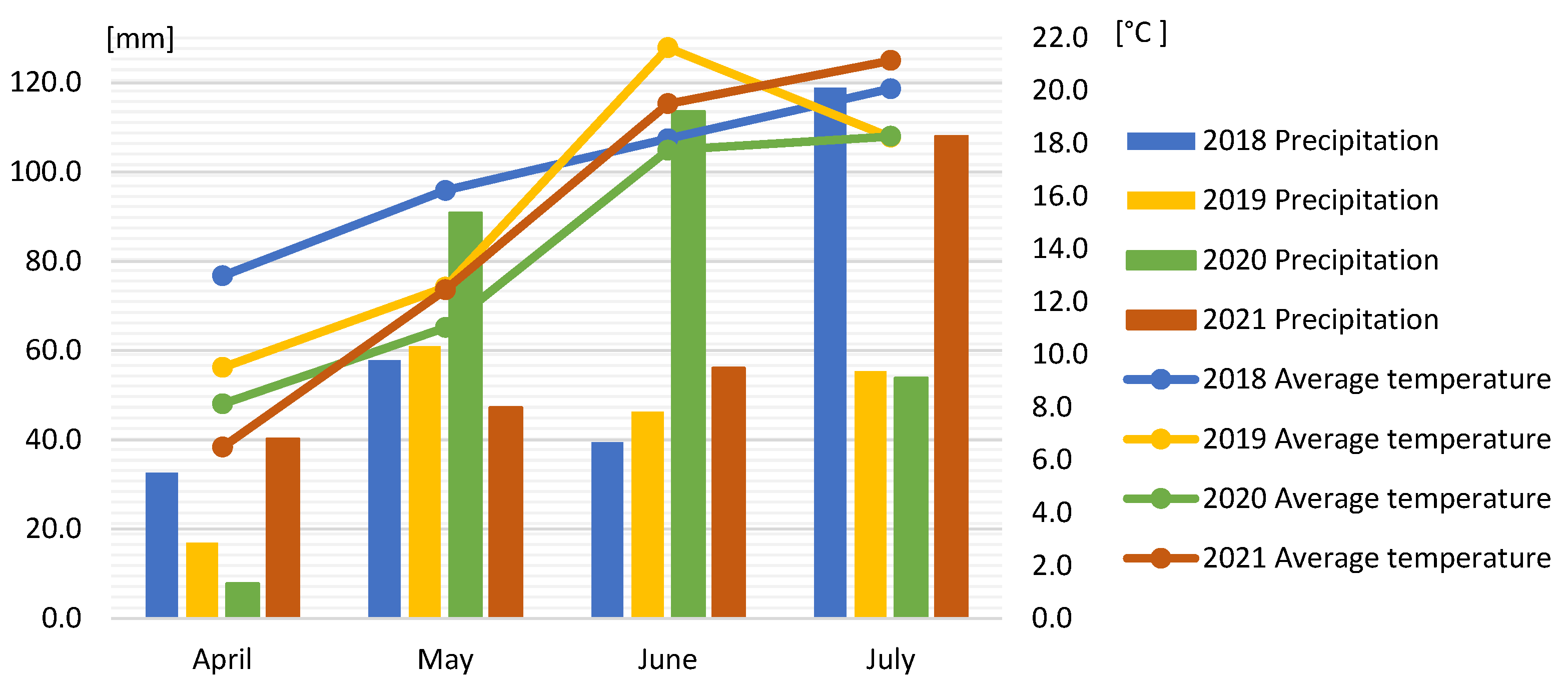
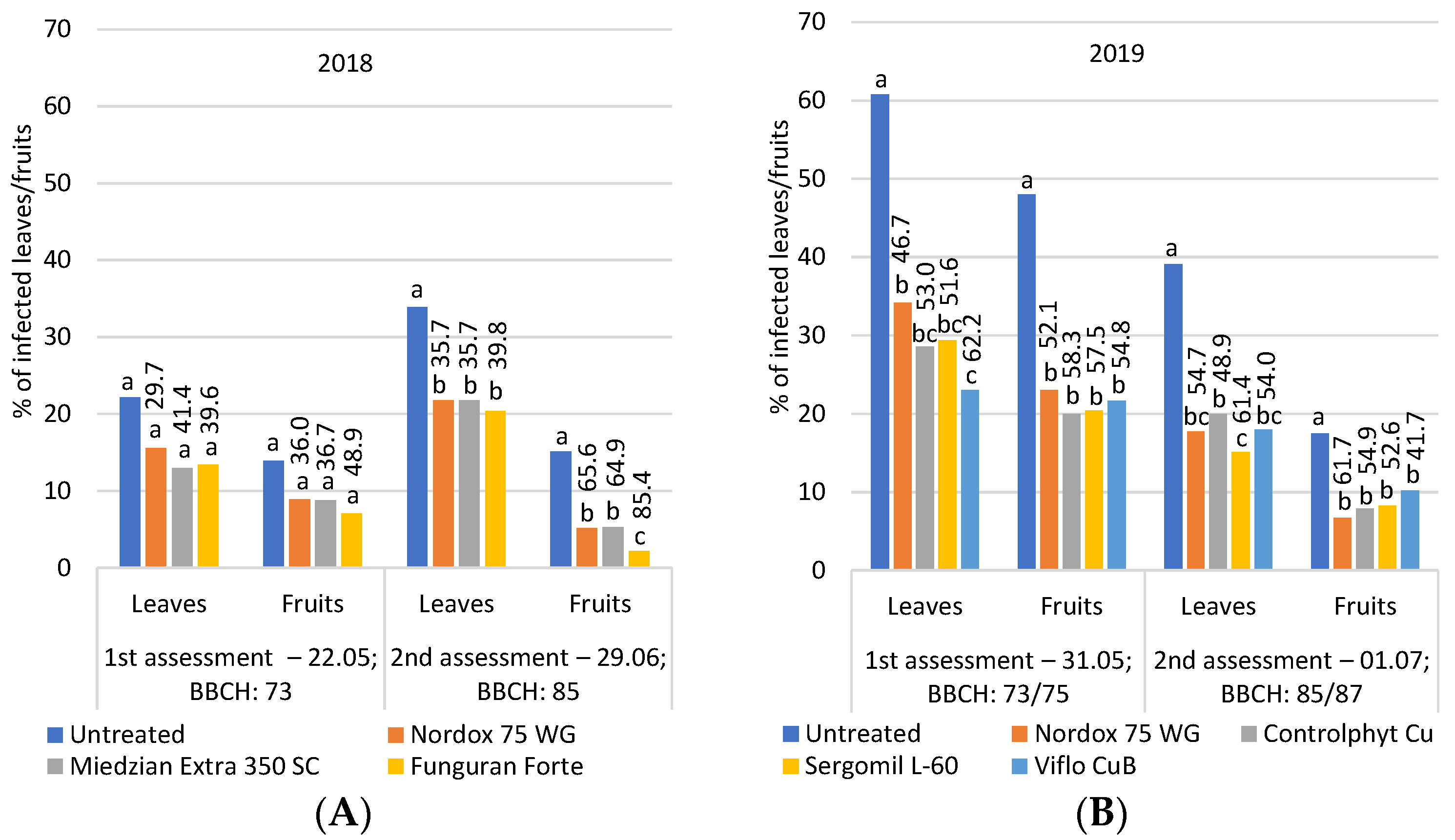

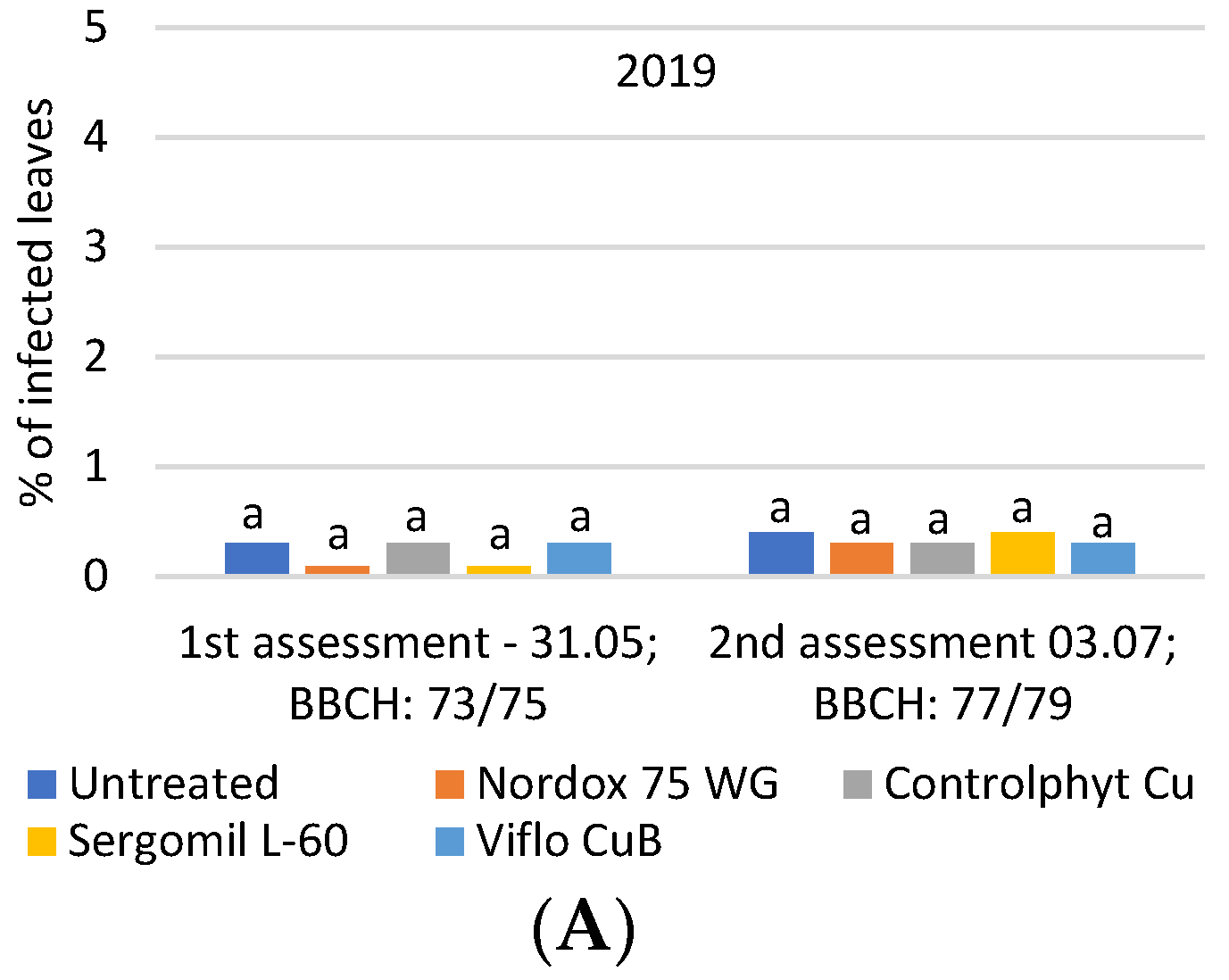
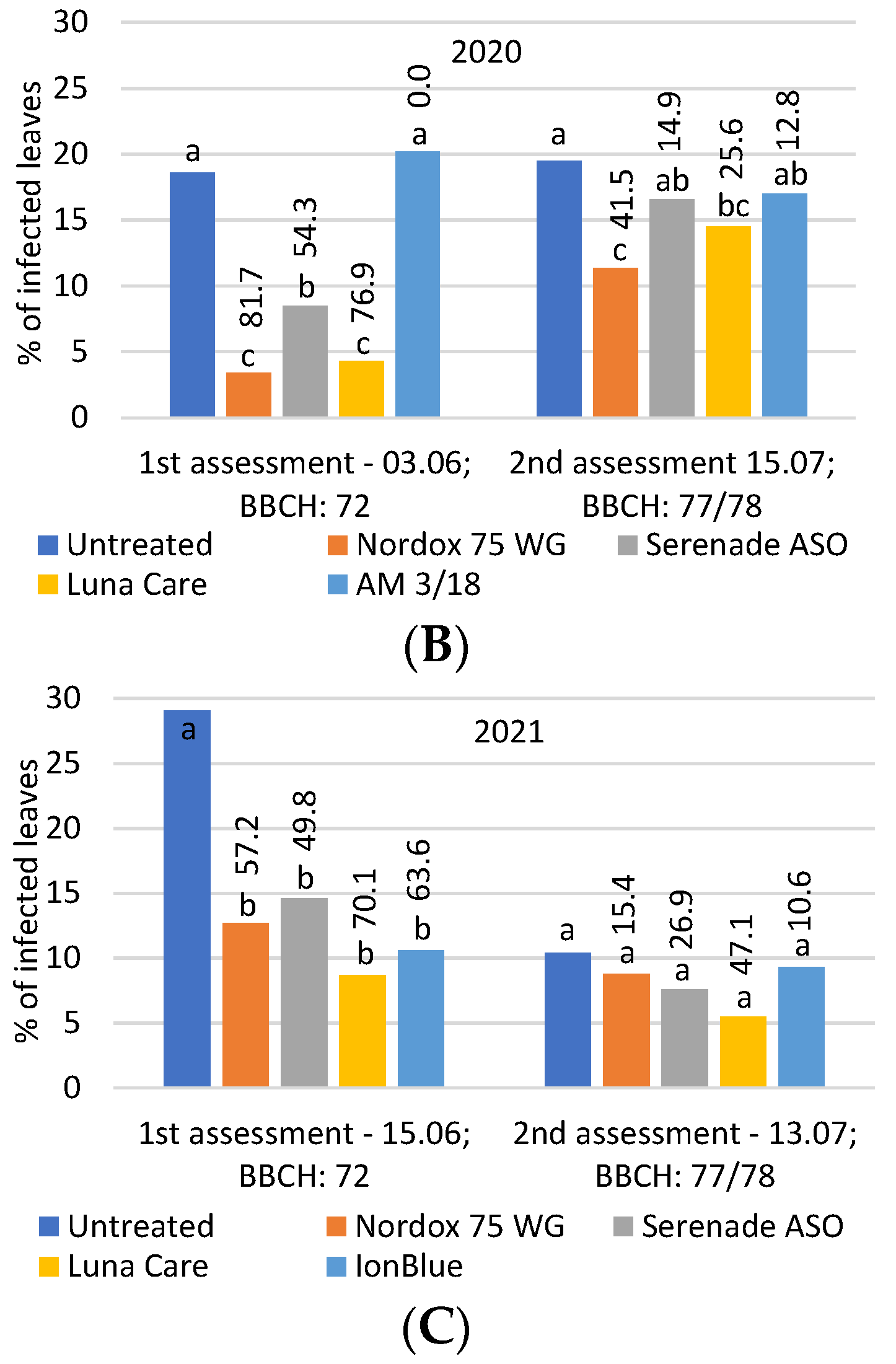

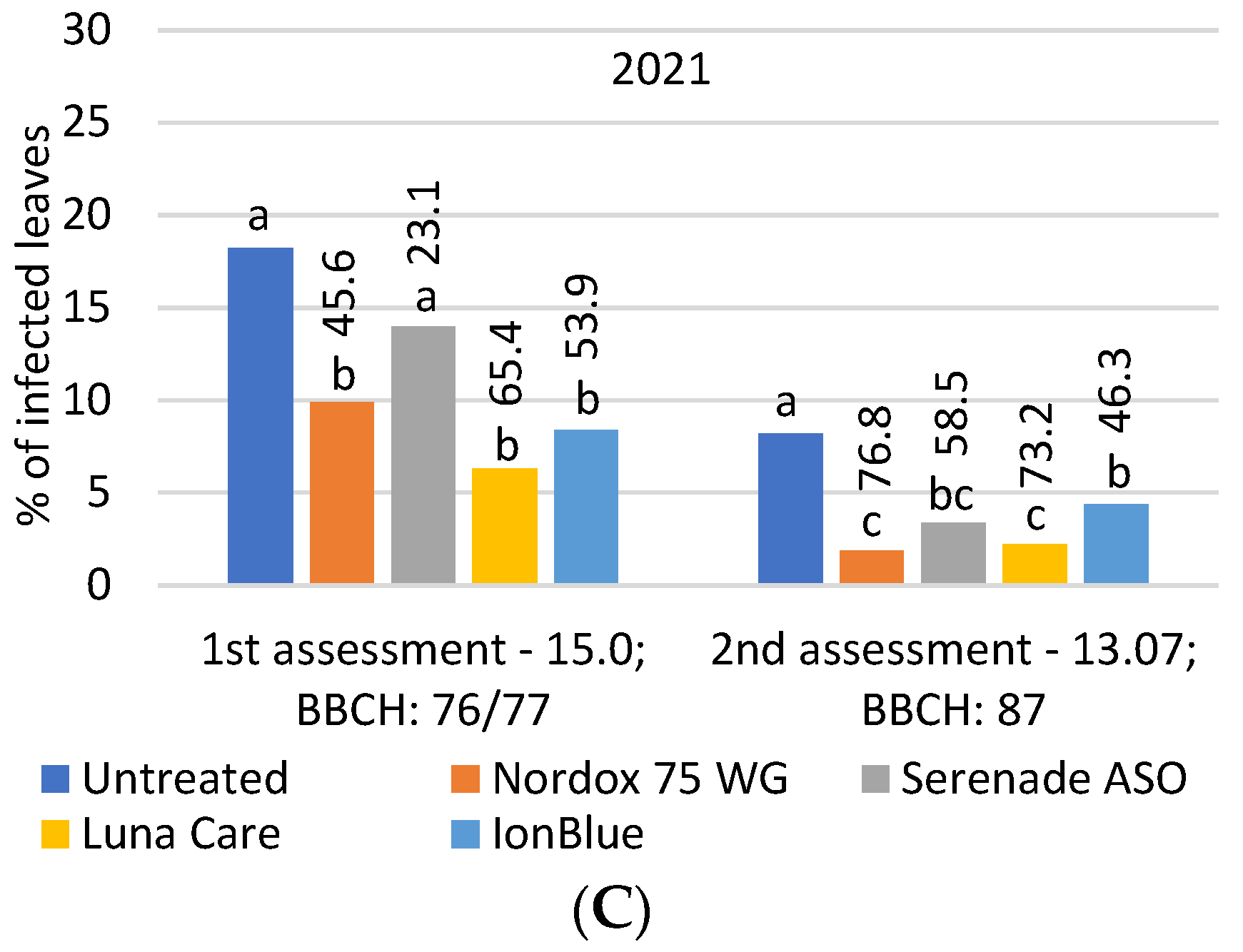
| Product | Dose per 1 ha or Concentration | Composition |
|---|---|---|
| 2018—sour cherry | ||
| Nordox 75 WG | 1.0 kg/ha | copper oxide—750 g/kg |
| Miedzian Extra 350 SC | 3.0/1.5 L/ha * | copper oxychloride—350 g/L |
| Funguran Forte A-PLUS | 2.0/1.5 kg/ha * | copper hydroxide—500 g/kg |
| NEW 50 WP | ||
| 2019—sour cherry, sweet cherry and plum | ||
| Nordox 75 WG | 1.0 kg | copper oxide—750 g/kg |
| Controlphyt Cu | 0.4% | 6.5% copper in the form of copper gluconate |
| Sergomil L-60 | 2.0 L | 5.5% copper in the form of copper gluconate |
| Viflo CuB | 2.0 L | 4% copper in the form of copper gluconate, 2% potassium (K), 1.8% boron (B) and 0.5% manganese (Mn) |
| 2020—sour cherry, sweet cherry and plum | ||
| Nordox 75 WG | 1.0 kg | copper oxide—750 g/kg |
| Serenade ASO | 8.0 L | bacteria Bacillus amyloliquifaciens strain QST 713—13.96 g/L (minimum concentration 1.042 × 1012 CFU/L) |
| Luna Care 71.6 WG | 3.0 L | fluopyram—50 g/kg and fosetyl-Al—666 g/kg |
| AM3/18 | 73.5 g/1 L of water | prototype formulation containing bacteria Pantoea agglomerans—107 CUF/mL |
| 2021—sour cherry, sweet cherry and plum | ||
| Nordox 75 WG | 1.0 kg | copper oxide—750 g/kg |
| Serenade ASO | 8.0 L | bacteria Bacillus amyloliquifaciens strain QST 713—13.96 g/L (minimum concentration 1042 × 1012 CFU/L) |
| Luna Care 71.6 WG | 3.0 L | fluopyram—50 g/kg and fosetyl-Al—666 g/kg |
| IonBlue | 1.5 L | copper—5.1% and sulfur—4.97% in the form of nanoparticles |
Disclaimer/Publisher’s Note: The statements, opinions and data contained in all publications are solely those of the individual author(s) and contributor(s) and not of MDPI and/or the editor(s). MDPI and/or the editor(s) disclaim responsibility for any injury to people or property resulting from any ideas, methods, instructions or products referred to in the content. |
© 2023 by the authors. Licensee MDPI, Basel, Switzerland. This article is an open access article distributed under the terms and conditions of the Creative Commons Attribution (CC BY) license (https://creativecommons.org/licenses/by/4.0/).
Share and Cite
Broniarek-Niemiec, A.; Børve, J.; Puławska, J. Control of Bacterial Canker in Stone Fruit Trees by Chemical and Biological Products. Agronomy 2023, 13, 1166. https://doi.org/10.3390/agronomy13041166
Broniarek-Niemiec A, Børve J, Puławska J. Control of Bacterial Canker in Stone Fruit Trees by Chemical and Biological Products. Agronomy. 2023; 13(4):1166. https://doi.org/10.3390/agronomy13041166
Chicago/Turabian StyleBroniarek-Niemiec, Agata, Jorunn Børve, and Joanna Puławska. 2023. "Control of Bacterial Canker in Stone Fruit Trees by Chemical and Biological Products" Agronomy 13, no. 4: 1166. https://doi.org/10.3390/agronomy13041166
APA StyleBroniarek-Niemiec, A., Børve, J., & Puławska, J. (2023). Control of Bacterial Canker in Stone Fruit Trees by Chemical and Biological Products. Agronomy, 13(4), 1166. https://doi.org/10.3390/agronomy13041166






